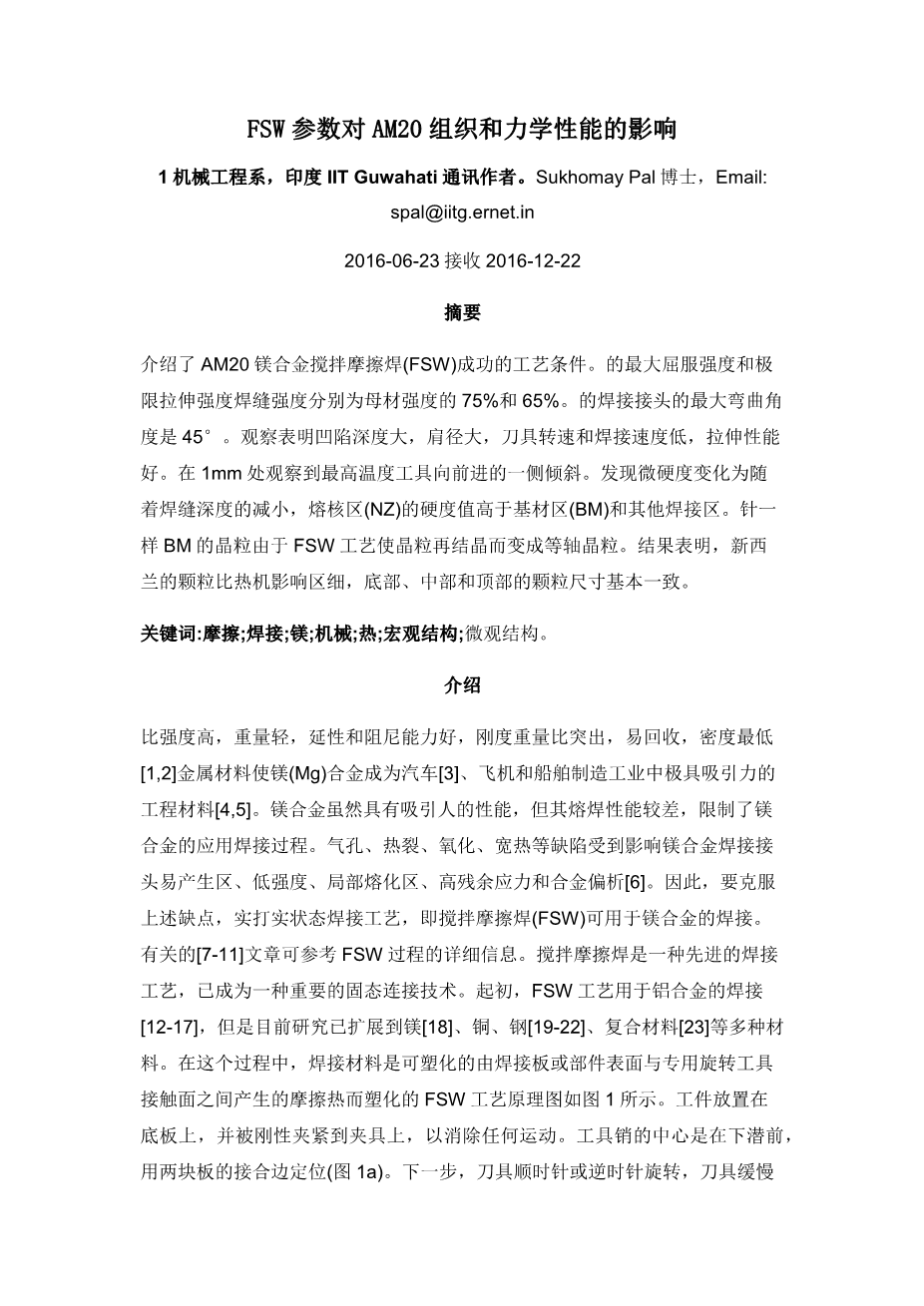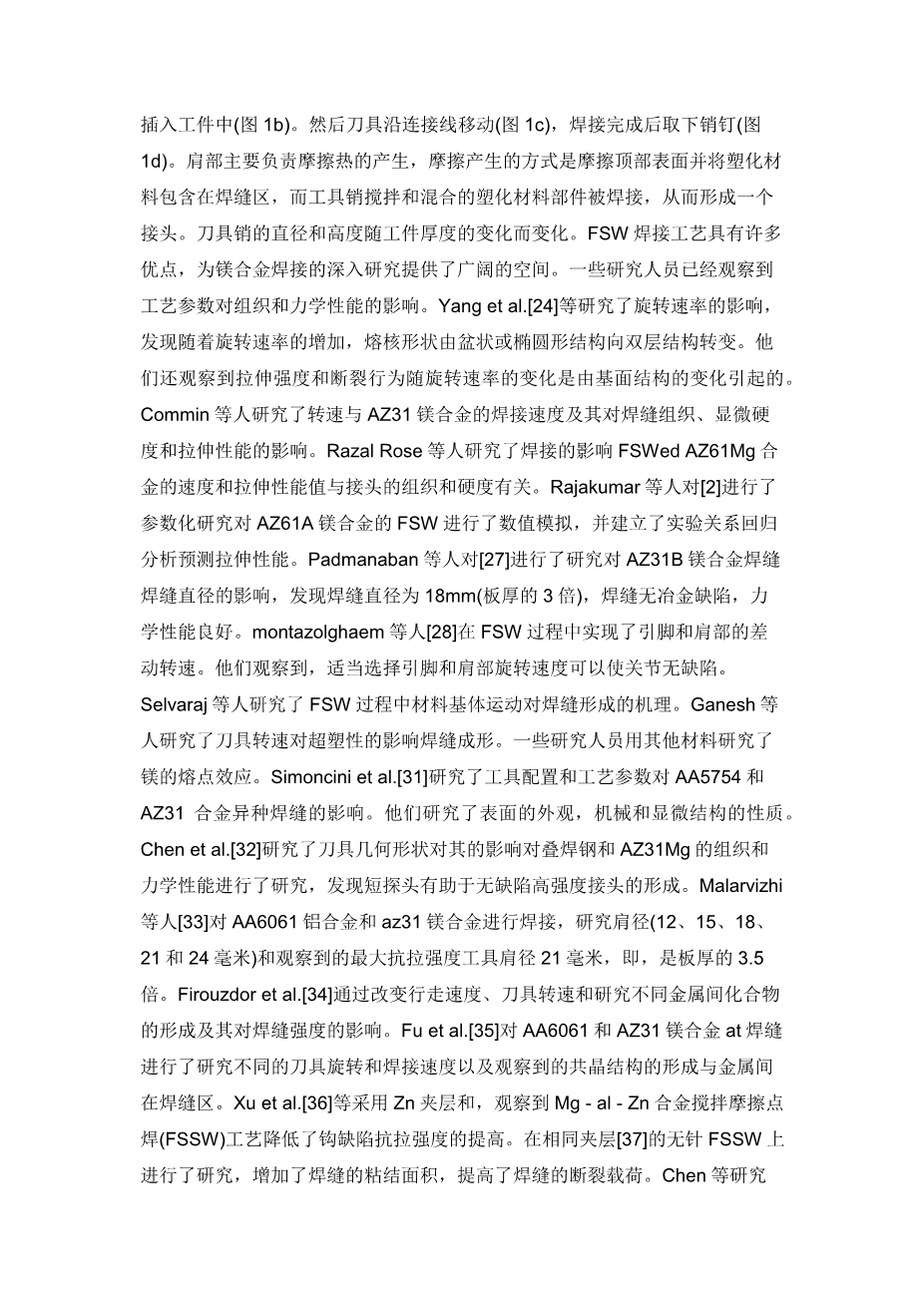骨架油封自动分拣装置的设计外文翻译资料
2022-07-19 09:07
Effect of FSW Parameters on Microstructure and Mechanical Properties of AM20
welds Prakash Kumar Sahu1, Sukhomay Pal1 1Mechanical Engineering Department, IIT Guwahati, India Corresponding author. Dr. Sukhomay Pal, Email: spal@iitg.ernet.in
Received 2016-06-23 Accepted 2016-12-22
Abstract
This paper aims to demonstrate the successful friction stir welding (FSW) conditions of AM20 magnesium alloy. The maximum yield strength and ultimate tensile strength of weld were found to be 75% and 65% of the base metal strength, respectively. The maximum bending angle of the welded joint was 45°. Observations revealed that less plunging depth, high shoulder diameter and low tool rotational speed and welding speed give better tensile properties. Maximum temperature was observed at 1 mm away from the tool shoulder towards the advancing side. Micro-hardness variation is found to be decreasing along the depth of the weld, and nugget zone (NZ) gives the higher hardness values when compared with base material (BM) and other welded zones. Needle like grains of the BM became equiaxed grains due to grain recrystalized by the FSW process. The grains in the NZ were finer than thermo mechanically affected zone and almost same size of grains observed at bottom, middle and top of the NZ.
KEYWORDS: Friction; Welding; Magnesium; Mechanical; Thermal; Macrostructure; Microstructure.
INTRODUCTION
High specific strength, light weight, ductility and damping capacity, outstanding stiffness to weight ratio, ease of recyclability, and lowest density [1, 2] among engineering metallic materials makes magnesium (Mg) alloys an attractive engineering material for the automobile [3], aircraft, and ship building industries [4, 5]. In spite of its attractive properties, the use of Mg alloys is limited mainly due to its poor weldability by fusion welding processes. The defects like porosity, hot cracking, oxidation, wide heat aff ected zone, low strength, partial melting zone, high residual stress, and alloy segregation [6] are prone in Mg welded joint. Therefore, to overcome the above mentioned drawback, solid state welding process, namely friction stir welding (FSW) can be exploited to weld Mg alloys. Details of the FSW process may be consulted in related [7-11] articles.FSW is an advanced welding process and has emerged as an important solid state joining technique. At first FSW process was used for welding of aluminium alloys [12-17] but now the research has been extended to a variety of materials including magnesium [18], copper, steels [19-22] and composites [23]. In this process, the welded material is plasticized by frictional heat generated between the surface of the plates or components to be welded and the contact surface of a special rotating tool. A schematic diagram of the FSW process is shown in Fig. 1. The workpiece is placed on a backing plate and is clamped rigidly to a fixture to eliminate any movement. The center of the tool pin is
positioned with the joint edge of the two plates before plunging (Fig.1a). In the next step, the tool rotates either in clockwise or anticlockwise direction and the tool plunges slowly into the workpiece (Fig.1b). Then the tool moves along the joint line (Fig.1c) and finally the pin is removed after completion of welding (Fig.1d). Shoulder is mainly responsible for friction heat generation by rubbing on the top surfaces and containing the plasticized material in the weld zone, while tool pin stirs and mixes the plasticized material of the components to be welded, thus creating a joint. The diameter and height of the tool pin vary with the workpiece thickness.FSW process offers many advantages and scope for detailed investigation of welding Mg alloys is worthwhile. Effect of process parameters on the microstructural and mechanical properties have been observed by some researchers. Yang et al. [24] studied the effects of rotation rates and observed that as the rotation rate increases the nugget shape varies from basin or ellipse shaped structure to a two-layer structure. They also observed variation of tensile strength and fracture behaviour with rotation rate were accounted by the variation in texture of basal plane. Commin et al. [25] investigated ratio of rotation speed to welding speed on AZ31 Mg alloy and its effect on grain structure, micro-hardness and tensile properties of the weld. Razal Rose et al. [26] studied the influence of welding speed of the FSWed AZ61Mg alloy and tensile properties values are correlated with the microstructure and hardness of the joint. Rajakumar et al. [2] did parametric study on FSW of AZ61A magnesium alloy and developed an empirical relationship using regression analysis to predict tensile properties. Padmanaban et al. [27] investigated effect of shoulder diameter to AZ31B Mg alloy weld and found that the joint produced with 18 mm shoulder diameter (3 times of plate thickness) is metallurgically defect free and mechanically sound welds. Montazerolghaem et al. [28] implemented differential rotation speeds of pin and shoulder in the FSW process. They observed that appropriate selection of pin and the shoulder rotation speeds results in defect-free joints. Selvaraj et al. [29] investigated mechanism of material matrix movement to weld formation in FSW process. Ganesh et al. [30] investigated role of tool rotational speed on superplastic forming of weld joint. Some researchers investigated FSW of Mg with other materials. Simoncini et al. [31] investigated effect of tool configuration and process parameters on dissimilar weld of AA5754 and AZ31 alloys. They studied surface appearance, mechanical and microstructural properties. Chen et al. [32] investigated the effect of tool geometry on microstructure and mechanical properties of lap welded steel and AZ31Mg and observed that short probe contributed to defect-free and high-
剩余内容已隐藏,支付完成后下载完整资料


英语译文共 11 页,剩余内容已隐藏,支付完成后下载完整资料
资料编号:[453449],资料为PDF文档或Word文档,PDF文档可免费转换为Word




